The Eastern region covers the counties immediately north and east of London, otherwise known as East Anglia. The region covers the counties of Essex, Hertfordshire, Bedfordshire, Cambridgeshire, Suffolk and Norfolk. In 2005, the Conservatives won 40 seats to 13 for the Labour Party and 3 for the Liberal Democrats.
The recent redistribution saw Norfolk and Essex each gain a seat, which were both considered notionally Conservative. A 2009 by-election also saw the Labour seat of Norwich North lost to the Conservatives.
The East is Conservative-dominated, and does not include any major cities, although parts of Hertfordshire and Essex are effectively extensions of the London metropolitan area. Labour holds the two seats covering Luton, the seats covering Bedford and Ipswich, two seats in Hertfordshire, three seats in Essex, Norwich South, and two seats along the Norfolk-Suffolk coast.
The Liberal Democrats hold the seats of Cambridge, Colchester, and Norfolk North.
All three Liberal Democrats seats have margins over 10%, whereas most Labour seats have smaller margins.
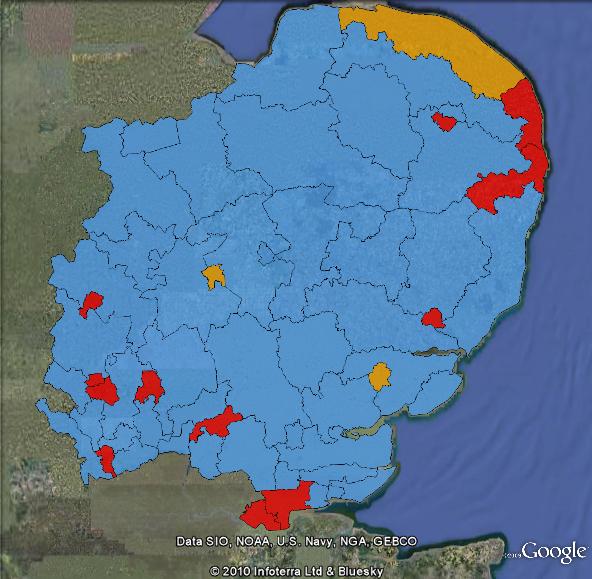
Recent history
- 1987 – 50 CON, 1 LAB
- 1992 – 47 CON, 4 LAB
- 1997 – 33 CON, 22 LAB, 1 LD
- 2001 – 34 CON, 20 LAB, 2 LD
- 2005 – 40 CON, 13 LAB, 3 LD
In 1987, Labour only managed to win one seat in Eastern England, being Norwich South, while the Conservatives won 50. In 1992, the Conservatives held all but four seats, with Labour gaining Cambridge, Ipswich and Thurrock. Even in the Labour landslide of 1997, the Conservatives won a majority of seats. The Liberal Democrats gained the seat of Colchester while Labour gained another eighteen.
In 2001, Labour lost two seats to the Conservatives, while the Liberal Democrats gained one seat off the Conservatives. In 2005, Labour lost another six seats to the Conservatives. The Liberal Democrats won a third seat, in Cambridge, in a campaign focused on the Iraq war and university fees. A 2009 by-election saw the Conservatives gain the seat of Norwich North off Labour.
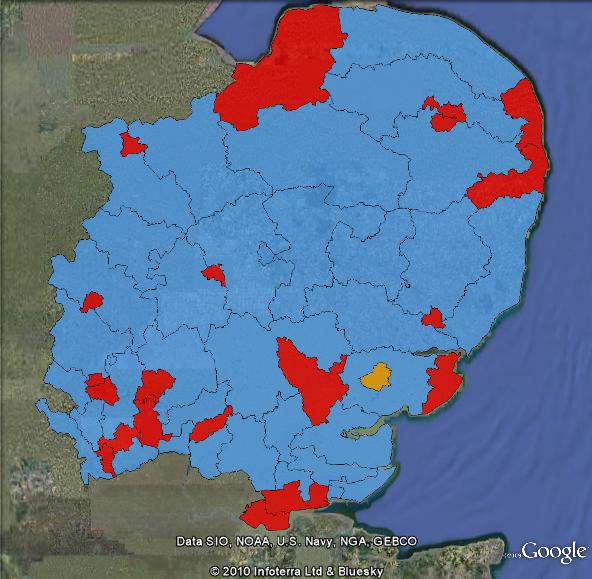
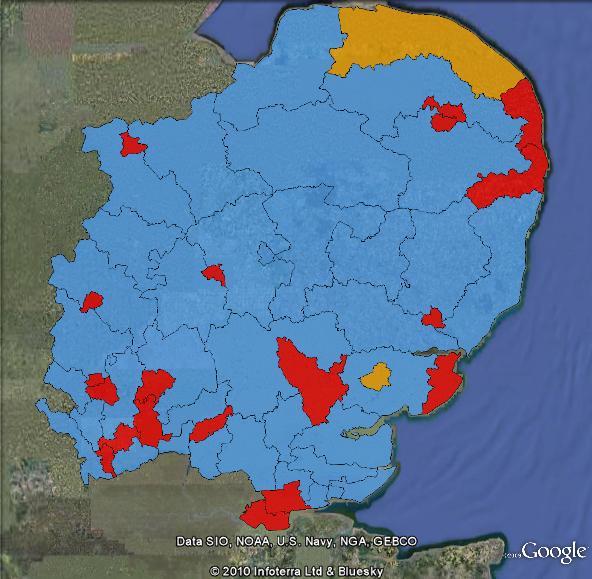
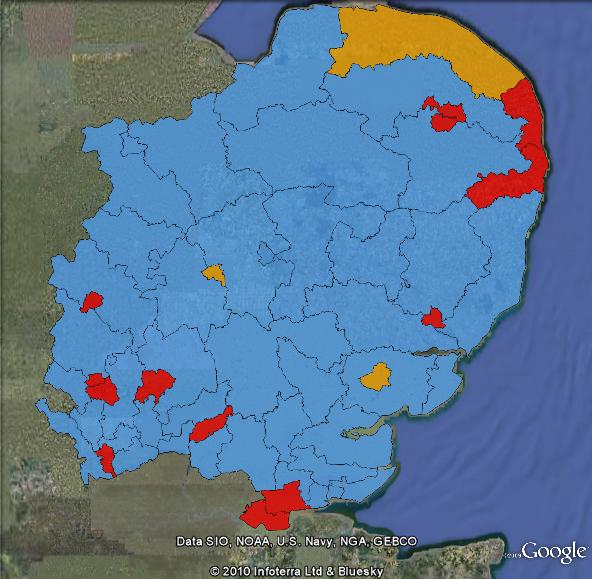
The key seats
- Cambridge – Held since 2005 by the Liberal Democrats, after a campaign focused on the Iraq war and university fees. Sitting Lib Dem MP David Howarth is stepping down after one term. The Lib Dems should hold on, although the Green Party is running Tony Juniper, former executive director of Friends of the Earth. While the Greens should perform strongly, they shouldn’t trouble the Lib Dems, and it is hard to see Labour making a comeback in this seat in 2010.
- Bedford, Great Yarmouth, Stevenage – these three Labour seats are 62nd, 67th and 70th on the Conservative target list. If the Conservatives are to be the largest party in the Commons, they will need to be winning seats around this range.
- Harlow – an Essex seat lying north of London, Harlow is Labour-held but is 6th on the Conservative target list, so you can expect this seat to be one of the first to fall if there is a swing towards the Tories.
- Norwich South – This Labour seat is held by an 8% margin over the Liberal Democrats. It is also a strong area for the Green Party, who have a large presence on Norwich City Council and are standing Adrian Ramsay, the leader of the council group and the party’s Deputy Leader. While the Greens are working hard to convince progressive voters that they are a viable alternative to Labour and Liberal Democrats, they polled only 7% in 2005. While the Greens vote should go up, you’d expect the Liberal Democrats to take the seat.
- South Basildon & East Thurrock, Thurrock – These two Labour seats lie on the north shore of the Thames east of London. South Basildon & East Thurrock is 31st on the Conservative target list, while Thurrock is 125th.
- Watford, St Albans – these two Hertfordshire constituencies are both genuine three-cornered contests. Only 4% separates first-place Labour from third-place Liberal Democrats in Watford, while the Conservatives have a 3% margin over Labour in St Albans, with the Lib Dems trailing on 25%.
- Luton North, Luton South – these two Labour seats have long been bellwether seats, with Luton (either as one seat or two) predicting the result of every election bar one since the 1930s. Luton South is 140th on the Conservative list, while Luton North is 158th. In addition, the expenses scandal hit hard in the southern constituency, where sitting MP Margaret Moran is retiring after making large claims on her expenses. As well as the major party candidates, television presenter Esther Rantzen is standing as an independent in protest at the major parties’ involvement in the expenses scandal.
- Castle Point – This Conservative seat is held with an 18% margin over the Labour Party, which would normally suggest it would be very safe in 2010. However, sitting Conservative MP Bob Spink was on the right-wing fringe of the party and left the party in 2008. After flirting with the UK Independence Party, he is standing as an independent, and could split the right-wing vote.
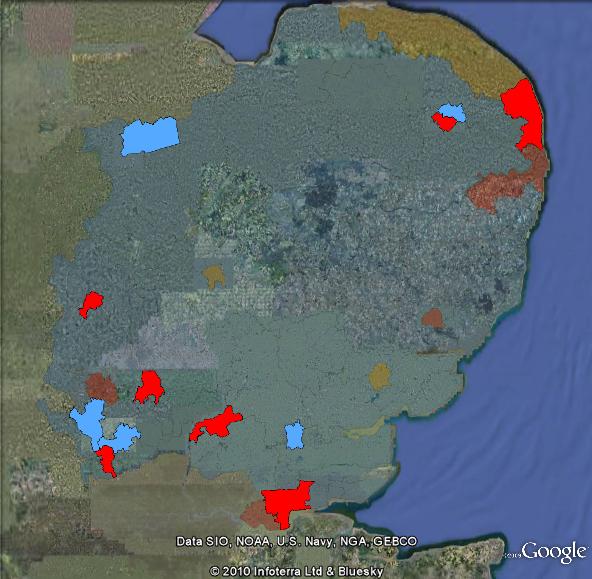
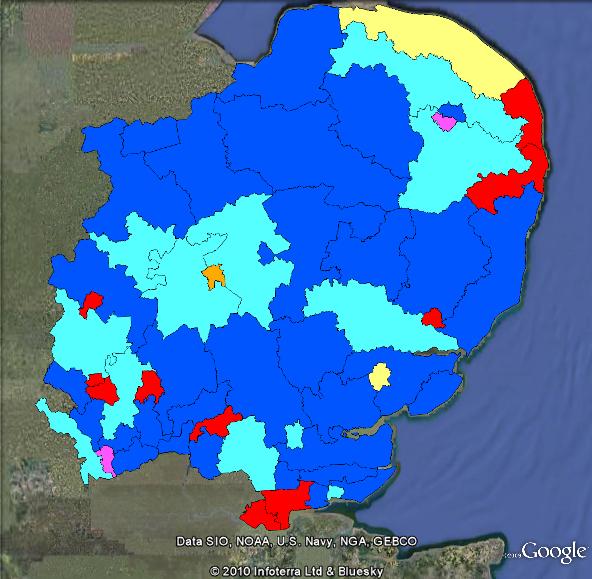
Elsewhere: profiles of the election in Eastern England at The Guardian and UK Polling Report.


My prediction: CON 49, LAB 3, LD 6.